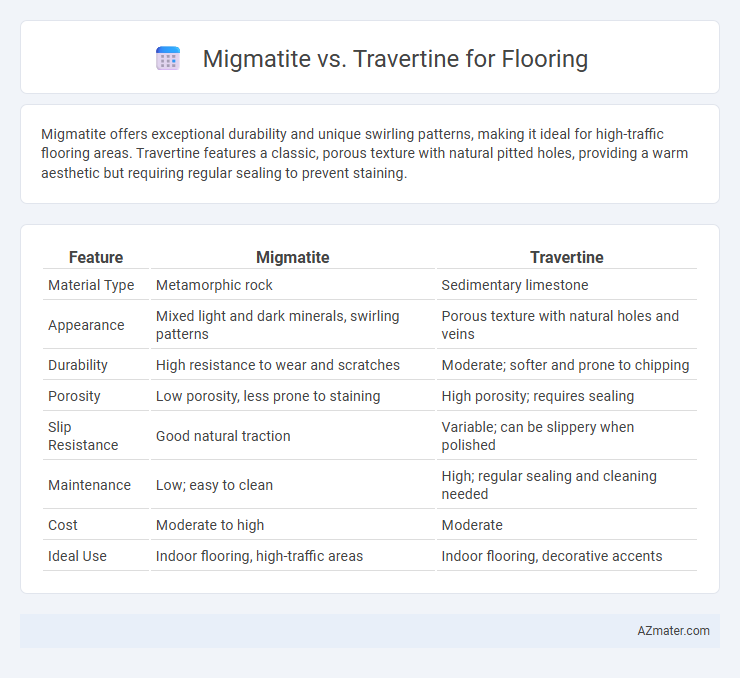Migmatite offers exceptional durability and unique swirling patterns, making it ideal for high-traffic flooring areas. Travertine features a classic, porous texture with natural pitted holes, providing a warm aesthetic but requiring regular sealing to prevent staining.
Table of Comparison
| Feature | Migmatite | Travertine |
|---|---|---|
| Material Type | Metamorphic rock | Sedimentary limestone |
| Appearance | Mixed light and dark minerals, swirling patterns | Porous texture with natural holes and veins |
| Durability | High resistance to wear and scratches | Moderate; softer and prone to chipping |
| Porosity | Low porosity, less prone to staining | High porosity; requires sealing |
| Slip Resistance | Good natural traction | Variable; can be slippery when polished |
| Maintenance | Low; easy to clean | High; regular sealing and cleaning needed |
| Cost | Moderate to high | Moderate |
| Ideal Use | Indoor flooring, high-traffic areas | Indoor flooring, decorative accents |
Introduction to Migmatite and Travertine Flooring
Migmatite flooring features a unique blend of metamorphic rock with intermingled igneous textures, offering exceptional durability and distinctive veining patterns that enhance interior aesthetics. Travertine flooring consists of sedimentary limestone formed by mineral deposits from springs, prized for its warm tones and natural surface pits that provide slip resistance. Both materials serve as premium flooring options, balancing natural beauty with functional strength in residential and commercial spaces.
Geological Origins: Migmatite vs Travertine
Migmatite forms through intense regional metamorphism where partial melting of metamorphic rocks creates a unique blend of igneous and metamorphic textures, resulting in a durable and complex stone ideal for flooring. Travertine originates from the rapid precipitation of calcium carbonate in hot springs and limestone caves, producing porous, sedimentary layers with natural pits and veins beneficial for slip resistance in flooring applications. The contrasting geological origins influence their structural properties: migmatite's high-grade metamorphic formation yields exceptional strength, while travertine's sedimentary deposition offers distinctive aesthetic appeal with softer durability.
Appearance and Aesthetic Differences
Migmatite flooring features a unique blend of metamorphic textures with swirling patterns of light and dark minerals, creating a dramatic, natural appearance ideal for rustic or sophisticated interiors. Travertine offers a more uniform, porous surface with soft, earthy tones and subtle veining that enhances Mediterranean or classic design schemes. The choice between migmatite's bold, variegated aesthetics and travertine's elegant, smooth look depends on desired visual impact and architectural style.
Durability and Hardness Comparison
Migmatite offers exceptional durability and hardness due to its metamorphic origin, making it highly resistant to scratches, impact, and wear, ideal for high-traffic flooring areas. Travertine, a sedimentary limestone, is softer and more porous, requiring regular sealing to enhance its durability and prevent chipping or staining. For flooring applications demanding long-lasting strength and minimal maintenance, migmatite outperforms travertine in both hardness and structural integrity.
Porosity and Water Resistance
Migmatite features low porosity and excellent water resistance, making it highly durable and ideal for flooring in moisture-prone areas. Travertine, characterized by its naturally porous structure, requires sealing to enhance water resistance and prevent staining or damage over time. Choosing migmatite ensures a more maintenance-free floor, while travertine demands regular care to maintain its appearance in wet environments.
Installation Requirements and Methods
Migmatite flooring demands professional installation due to its complex natural stone composition, requiring skilled cutting and sealing to prevent cracking and staining. Travertine, being a softer sedimentary rock, needs careful handling and grout application during installation to accommodate its porous surface and avoid surface damage. Both materials benefit from a moisture barrier and a level subfloor, but travertine often requires additional sealing to maintain durability and appearance in high-traffic areas.
Maintenance and Cleaning Considerations
Migmatite flooring requires regular sealing and gentle cleaning with pH-neutral products to prevent damage from acids and ensure long-term durability. Travertine floors demand frequent sealing to counteract their porous nature, alongside routine sweeping and mopping to avoid dirt infiltration and staining. Both materials benefit from immediate spill cleanup and avoidance of harsh chemicals to maintain aesthetic appeal and structural integrity.
Cost Analysis: Migmatite vs Travertine
Migmatite flooring typically costs between $7 to $15 per square foot, offering a durable and unique natural stone option with excellent resistance to wear. Travertine prices range from $4 to $10 per square foot, making it a more budget-friendly choice that provides a classic aesthetic but may require more maintenance. Budget considerations for installation and long-term upkeep often favor travertine for affordability, while migmatite appeals to those seeking higher durability despite higher initial costs.
Environmental Impact and Sustainability
Migmatite flooring, formed through high-grade metamorphism, offers exceptional durability and a natural resistance to wear, reducing the frequency of replacement and thereby minimizing environmental waste. Travertine, a sedimentary limestone rich in calcium carbonate, is often quarried with less environmental disruption but requires sealing and maintenance to prevent degradation, influencing its long-term sustainability. Choosing between migmatite and travertine involves weighing migmatite's long lifespan and robustness against travertine's more environmentally friendly extraction process and aesthetic appeal.
Best Applications and Recommendations for Use
Migmatite offers exceptional durability and unique, swirling patterns ideal for high-traffic areas such as commercial lobbies and modern residential interiors, where a natural stone with a distinctive appearance is desired. Travertine provides a softer, more porous surface with classic earth-toned hues, making it best suited for low-traffic zones like bathrooms, patios, and Mediterranean-inspired design schemes. For flooring, select migmatite when strength and longevity are priorities, and travertine for warmth and an elegant, timeless aesthetic in controlled environments.

Infographic: Migmatite vs Travertine for Flooring
 azmater.com
azmater.com